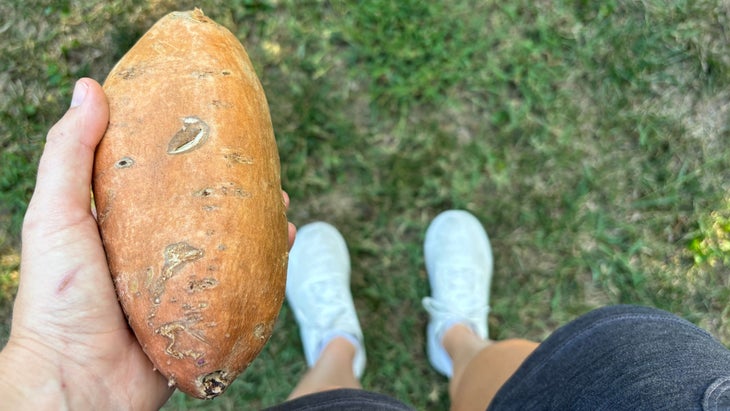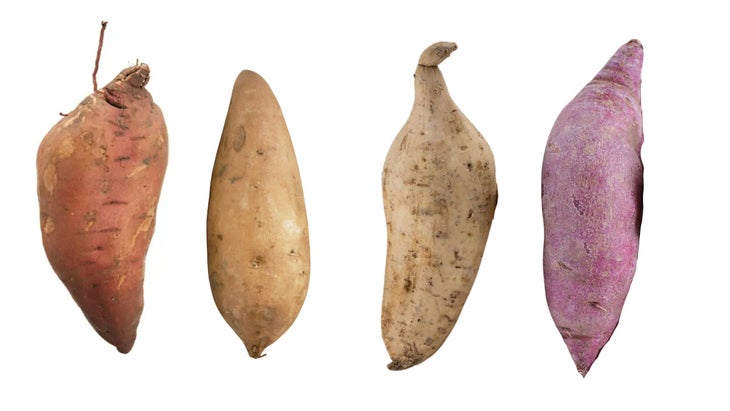“], “filter”: { “nextExceptions”: “img, blockquote, div”, “nextContainsExceptions”: “img, blockquote, a.btn, a.o-button”} }”>
New perk: Easily find new routes and hidden gems, upcoming running events, and more near you. Your weekly Local Running Newsletter has everything you need to lace up!
>”,”name”:”in-content-cta”,”type”:”link”}}”>Subscribe today.
A few years ago, my skin started to turn a lovely (not so much) shade of orange. My palms and knuckles were particularly stained a shade of tangerine. It got to a point where my own mother begged me to, “Stop using self tanner!” because it was not a good look. The thing was, I wasn’t tanning, I was just eating a lot of sweet potatoes.
A lot.
After a quick explanation from my doctor, my worries that I was going to turn into a traffic cone were alleviated. As a runner, sweet potatoes are my bread and butter. Not only are they a low-glycemic carb source with natural sugars for energy, but they also contain the antioxidant beta-carotene, which can help the body fight inflammation. And after an hour or two of pounding the pavement five days a week, I have a lot of inflammation.
It’s also this beta-carotene that caused my skin to turn orange. The antioxidant gives sweet potatoes their trademark hue, and if you consume enough, it will also turn your body a similar shade. While it’s never good to overdo it on any food, nutrition professor at Boston University (BU), Joan Salge Blake, tells me this side effect isn’t harmful—just unsightly.

“Orange flesh sweet potatoes are packed with beta-carotene, a phytochemical that gets converted to Vitamin A as your body needs it,” Blake says. “Beta-carotene is nontoxic, so you can eat copious amounts and nothing will happen. It’s also stored right under your skin in the inner fat, so you’re going to see it come through more on your palms and the soles of your feet.”
Blake says this reaction isn’t super common, except for those who take it too far (me) and have two massive sweet potatoes a day (me) for years (me).
I am not willing to walk around looking like I rolled around in Cheetos dust, but I’m also not about to give up a kind of food that fuels my runs. Luckily, there are plenty of other sweet potatoes—up to 400-plus kinds—that don’t contain the orange phytochemical. And though there’s no need for anyone to fear this orange tint, my experience brought up an interesting question. With so many sweet potato varieties, is there one in particular that will give endurance athletes the most benefits?
RELATED: I Replaced Running Gels with Real Food and This Is What Happened
How Many Sweet Potato Varieties Are There?
To learn about the hundreds of varieties (and what that really means), I asked Mississippi State University Extension Sweet Potato Expert Lorin Harvey to explain further.
There are 400-plus sweet potato varieties—defined as a group of plants within a species that has one or more distinguishing characteristics—there are more than 7,000 cultivars. Cultivars (Acadian, Carolina Brunch, Darby, Kandee, just to name a few) are specifically cultivated varieties of sweet potatoes, bred or developed for taste, size, yield, or disease resistance.
“For example, you have the purple flesh sweet potato variety, which encompasses a lot of different species. If you like a plant’s characteristics, you can select and maintain it so that it becomes a cultivar. It’s part of a variety, but it is its own individual plant.”
What Kind of Sweet Potatoes Are Best for Runners?

Though we’ve just rattled off a lot of big numbers, Harvey, says the majority of sweet potatoes fall into five basic types. Orange flesh sweet potatoes, purple flesh sweet potatoes, red skin sweet potatoes, and white sweet potatoes. Below are a few of the most popular varieties, but the list doesn’t come close to accounting for all of them.
Common orange flesh sweet potatoes: Covington, Bayou Belle, Jewel, Porto Rico, Garnet, Bellevue, Burgundy, Beauregard.
Common white flesh sweet potatoes: Hannah, O’Hentry, Sumor, Muasaki, Satsuma-io (otherwise known as the Japanese sweet potato).
Common purple flesh sweet potatoes: Okinawa, Stokes Purple, Charleston Purple, Margarita, Sweet Caroline, Medusa.
Though most varieties are similar or identical in macros—fiber, sugar, carbs, vitamins—experts suggest that the darker the flesh, the higher the carbohydrate (the discrepancy is, however, minimal). The color of the flesh also determines its unique antioxidant and phytonutrient content.
“There isn’t one ‘king’ cultivar that is more healthy, as the nutritional profile of sweet potatoes fall into a pretty consistent range,” Harvey explains. “You do have two factors that I suppose could be used to judge them, which is anthocyanin and beta-carotene content.”
While purple flesh sweet potatoes contain anthocyanin, orange flesh sweet potatoes boast, as we said before, beta-carotene. The antioxidants have similar anti-inflammatory benefits, so instead of comparing which one is better for you, it might be more prudent to compare sweet potatoes to other foods.
One cup of orange sweet potato contains double the amount of beta-carotene that the average adult needs each day. However, you can get the same amount of the antioxidant in 100 grams of carrots, which is about four or five baby carrots. So if one day you have carrots at lunch, you might opt for a purple sweet potato at dinner because you’ve already consumed a healthy dose of beta-carotene.
Anthocyanin is also found in dark berries, red grapes, black plums, red cabbage, purple cauliflower, black beans, and, of course, purple sweet potatoes, which boast of 519 mg per 100g. To get the same amount of anthocyanin in, for example, blueberries, as you get in a purple sweet potato, you’d need to eat almost two pints.
Wild blueberries, however, are much higher in anthocyanin, ranging from 487mg per 100g of fruit, because their harsh growing environments force the fruit to develop higher levels of antioxidants.
All varieties of sweet potatoes are nutritious, but some may benefit specific people more than others depending on their diet and nutritional needs. Anthocyanins in purple flesh sweet potatoes, for example, have been found to protect against Type 2 Diabetes and heart disease. This antioxidant is great for runners, as it can combat oxidative stress and improve blood circulation, which results in healthier, long-lasting muscles.
On the other hand, Beta-carotene in orange flesh sweet potatoes has been proven to slow the progression of Age-Related Maculopathy in eyes. It can also reduce oxidative stress the same way Anthocyanins does, but Beta-carotene converts into vitamin A, which assists in building a strong immune system. So if you’re a runner who has an unlucky knack for getting sick dangerously close to race day, orange sweet potatoes might be for you. What matters most is the benefits you care about more should impact your sweet potato choice, plus (obviously) taste and texture preference.
And the sweet potato expert’s spud of choice? Harvey prefers a classic orange flesh Beauregard variety, which is common in the South. His selection is less about which one is “best,” and more about the potato’s tasty creamy texture.
“While some people like brown sugar and sweetness with their sweet potatoes,” Harvey says. “I like to go the savory route by cooking them in the air fryer and adding salt and cumin.”
He echoes what the rest of the experts in my sweet potato exploration have: you can’t go wrong with any sweet potato. So pick which one you like best, and enjoy.”
Or better yet, incorporate a variety of sweet potatoes so you get a rainbow of benefits.
